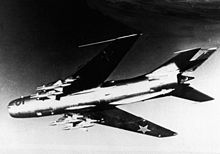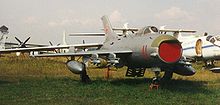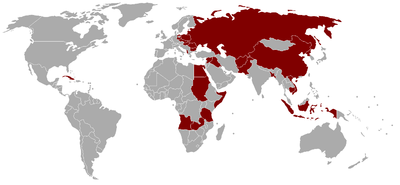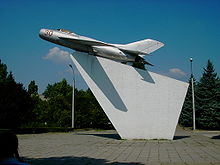Mikoyan-Gurevich MiG-19 Videos
|
Loading...
|
|
Mikoyan-Gurevich MiG-19
MiG-19
Role: Fighter
Manufacturer: Mikoyan-Gurevich OKB
First flight: 18 September 1953
Introduced: March 1955
Status: retired
Primary users: Soviet Air Force
People's Liberation Army Air Force
Number built: 2,172 (excl. China)
Variants: Shenyang J-6
Nanchang Q-5
The Mikoyan-Gurevich MiG-19 (Russian: ÐикоÑн и ÐÑÑÐµÐ²Ð¸Ñ ÐиÐ-19) (NATO reporting name: "Farmer") is a Soviet second-generation, single-seat, twin jet-engined fighter aircraft. It was the first Soviet production aircraft capable of supersonic speeds in level flight. A comparable U.S. "Century Series" fighter was the F-100 Super Sabre, although it would primarily oppose the more modern F-4 Phantom II and F-105 Thunderchief over North Vietnam.
Design and development
On 20 April 1951, OKB-155 was given the order to develop the MiG-17 into a new fighter called "I-340", which was to be powered by two Mikulin AM-5 non-afterburning jet engines (a scaled-down version of the Mikulin AM-3) with 19.6 kN (4,410 lbf) of thrust. The I-340 was supposed to attain 1,160 km/h (725 mph, Mach 0.97) at 2,000 m (6,562 ft), 1,080 km/h (675 mph, Mach 1.0) at 10,000 m (32,808 ft), climb to 10,000 m (32,808 ft) in 2.9 minutes, and have a service ceiling of no less than 17,500 m (57,415 ft). The new fighter, internally designated "SM-1", was designed around the "SI-02" airframe (a MiG-17 prototype) modified to accept two engines in a side-by-side arrangement and was completed in March 1952.
The prototype suffered from poor cockpit pressurization and the engines proved temperamental with frequent flameouts and surges with rapid throttle movements. The engines were upgraded to the AM-5A standard with 21.1 kN (4,740 lbf) of thrust each, which exceeded the power output of the Klimov VK-1F in afterburner while providing better fuel economy. The SM-1 was barely supersonic, reaching 1,193 km/h (745 mph) at 5,000 m (16,404 ft)-Mach 1.03. This performance was deemed insufficient for the new supersonic fighter and an afterburning version of the engine, the AM-5F, was proposed. While not implemented, the AM-5F served as the basis for the Tumansky RD-9 which powered production aircraft. Further development of the twin-engine concept resulted in a government request for the "I-360", internally designated "SM-2", which was also powered by the AM-5F engines, but featured a highly swept wing.
On 15 August 1953, the Mikoyan-Gurevich OKB was given a new order to create a frontline fighter. The OKB was asked to create two designs-a single-engined version with the Klimov VK-7 and a twin-engine version with Mikulin AM-9Fs. The twin-engine fighter, internally designated "SM-9"-but also assigned the production name MiG-19-was based on the earlier SM-2 prototype. The first airframe, "SM-9/1" flew on 5 January 1954. The afterburner did not light in the first flight, but in the second flight the aircraft reached Mach 1.25 at 8,050 m (26,411 ft). This was improved to Mach 1.44 in subsequent flights. Based on this promising performance, the MiG-19 was ordered into production on 17 February 1954, even though government acceptance trials did not start until September of that year. The first production aircraft rolled off the assembly line in March 1955.

Picture - MiG-19 armed with four Kaliningrad K-5 air-to-air missiles.
Initial enthusiasm for the aircraft was dampened by several problems. The most alarming of these was the danger of a midair explosion due to overheating of the fuselage fuel tanks located between the engines. Deployment of airbrakes at high speeds caused a high-g pitch-up. Elevators lacked authority at supersonic speeds. The high landing speed of 230 km/h (145 mph) (compared to 160 km/h (100 mph) in the MiG-15), combined with absence of a two-seat trainer version, slowed pilot transition to the type. Handling problems were addressed with the second prototype, "SM-9/2", which added a third ventral airbrake and introduced all-moving tailplanes with a damper to prevent pilot-induced oscillations at subsonic speeds. It flew on 16 September 1954, and entered production as the MiG-19S.
Approximately 5,500 MiG-19s were produced, first in the USSR and in Czechoslovakia as the Avia S-105, but mainly in the People's Republic of China as the Shenyang J-6. The aircraft saw service with a number of other national air forces, including those of Cuba, North Vietnam, Egypt, Pakistan, and North Korea. The aircraft saw combat during the Vietnam War, the 1967 Six Day War, and the 1971 Bangladesh War.
All Soviet-built MiG-19 variants are single-seaters only. Although the Chinese developed the JJ-6 trainer version of the Shenyang J-6, the Soviets believed that the MiG-19's handling was easy enough no special conversion trainer was needed (other than the MiG-15 UTI).
In the USSR, the MiG-19 was superseded by the MiG-21. The Shenyang J-6 remained a staple of the Chinese People's Liberation Army Air Force until the 1980s and has also been developed into the Nanchang Q-5 (NATO reporting name "Fantan") attack aircraft. Despite its age, the MiG-19 and its descendants exhibit good handling characteristics at low altitude and a surprisingly high rate of climb, and their heavy cannon armament-a one-second burst from three 30 mm NR-30 cannons had a projectile mass of 18 kg (40 lb)-makes them formidable adversaries in close combat.
Russian built MiG-19s still are in service in North Korea, Myanmar (Burma), Zambia and Nepal.
Operational history
During their service with Soviet Anti-Air Defense and in East Germany, MiG-19s were involved in multiple intercepts of Western reconnaissance aircraft. The first documented encounter with a Lockheed U-2 took place in the autumn of 1957. The MiG-19 pilot reported seeing the aircraft, but could not make up the 2,234 m (7,000 ft) difference in altitude. When Francis Gary Powers's U-2 was shot down in the 1960 incident, one pursuing MiG-19P was also hit by the salvo of S-75 Dvina (NATO: SA-2 "Guideline") missiles, killing the pilot Sergei Safronov. In a highly controversial incident, on 1 July 1960, a MiG-19 shot down an RB-47H (S/N 53-4281) reconnaissance aircraft in international airspace over the Arctic Circle with four of the crew killed and two captured by the Soviets (they were released in 1961). In another incident, on 28 January 1964, a MiG-19 shot down a T-39 Sabreliner which had strayed into East German airspace while on a training mission; all three crewmembers were killed.
Vietnam War
In early 1969, Hanoi made the decision to strengthen their air defenses by creating a third jet fighter unit; the 925th Fighter Regiment. This unit would consist of late model MiG-17s and the newly acquired MiG-19s (nearly all of which were J-6s from Communist China). The regiment was established at Yen Bai, and by April 1969, nine combat-rated MiG-19 pilots were posted for combat duty. While some of North Vietnam's MiG-17s and nearly all of their MiG-21s were supplied by the Soviet Union, the bulk of their MiG-19s (J-6 models) were supplied by Communist China, which seldom exceeded 54 MiG-19s in number.
The first use and loss of a U.S. fighter to a MiG-19 (J-6) was in 1965 when a USAF F-104 Starfighter piloted by LTC Philip E. Smith was "bounced" by a Communist Chinese aircraft near Hainan Island. His Starfighter took cannon fire which damaged a portion of his wing and missile mount. LTC Smith gave chase and did receive missile tone on the MiG, and within a millisecond of pressing his missile firing button, his Starfighter lost all power, and he had to eject. LTC Smith was held prisoner until his release in 1972, coincidentally during U.S. President Richard Nixon's visit to China in 1972. According to another source, Smith was released in 1973.
North Vietnam's Air Force used the MiG-19 much later in the air war than the MiG-17 and the MiG-21. MiG-19s, despite their limited numbers, were involved in extensive combat during Operations Linebacker 1 and Linebacker 2 (aka the Christmas Bombing). The NVAF claimed only seven victories using the MiG-19 over US aircraft, all of which were F-4 Phantom IIs. Primarily because of the aircraft's twin engines, which created a maintenance nightmare, the MiG-19 wasn't favored by North Vietnamese pilots. While the MiG-17 had maneuverability and the MiG-21 had speed, the MiG-19 had a combination of both, but not to the same degree as the others. North Vietnam used the MiG-19 from 1969 until the 1980s when it was replaced by newer aircraft.
Compared to the F-4 Phantom II however, although lacking mounts for air-to-air missiles, it had the one advantage that the early model Phantoms did not have: it was armed with cannons. Confirmed aerial victories by MiG-19s while assigned to the 925th FR, which match US records occurred on: 10 May 1972 in which two F-4 Phantoms were shot down by MiG-19s flown by Pham Hung Son and Nguyen Manh Tung. Both NVAF victories over the F-4s were accomplished by cannon fire, pilot Nguyen Tung's downed USAF F-4 Phantom was manned by Major Robert Lodge and his WSO 1st Lt Roger Locher. Combat results of the 925th FR using MiG-19s, according to the North Vietnamese Air Force were: two F-4s on 8 May 1972 (MiG-19 pilots: Nguyen Ngoc Tiep and Nguyen Hong Son); two F-4s on 10 May 1972 (MiG-19 pilots (both previously mentioned): Pham Hung Son and Nguyen Manh Tung); one F-4 on 18 May 1972; and two F-4s shot down on 23 May 1972 (MiG-19 pilots: Nguyen Hung Son and Pham Hung Son); these losses were in exchange for 10 MiG-19s lost in aerial combat with US jets. The MiG-19 did make history in one manner however; on 2 June 1972 over the skies of North Vietnam, the MiG-19 has the inauspicious honor of being the only recorded jet fighter to be shot down in aerial combat by cannon fire at supersonic speeds, by a USAF F-4 Phantom piloted by Major Phil Handley.
China
The MiG-19 apparently was in front line service with the PLAAF, and saw limited combat against their common adversary, the ROC Air Force (Nationalist China). One major air battle between Red and Nationalist Chinese aircraft occurred in 1967, with 12 J-6s taking on four Lockheed F-104 Starfighters. Each side claimed one kill.
There were reports of PRC J-6s (MiG-19s) flying combat missions during infrequent border squabbles with the Soviets, though with no records of dogfights, and encounters during the Vietnam War with US aircraft that strayed into Chinese airspace. These confrontations resulted in a few shootdowns of US aircraft, with no recorded losses of Chinese planes, although the MiGs sometimes had to make a hasty retreat back into Chinese airspace when the Americans flew in reinforcements.
In 1979, PRC conducted a punitive military incursion into Vietnam in protest of Vietnam's invasion of Khmer Rouge Cambodia. The operation did not go well for China, since the Vietnamese had well over 10 years of combat experience with the United States, and at least one J-6 was shot down.
Middle East
In 1962 Egyptian MiG-19s saw some action in the ground-attack role during the civil war in Yemen during the early 1960s. The first reported air combat in the Mideast with the MiG-19 was on 29 November 1966, when two Egyptian MiG-19 fighters were in an engagement with Israeli Mirage IIICs. The Israelis claimed two kills and no losses to themselves. Around 80 MiG-19s were in service with Egypt during the Six-Day War in 1967, but more than half were destroyed on the ground during the opening Israeli airstrikes from Operation Focus. Despite the unequal contest, Israeli pilots did find the MiG-19 a potentially dangerous adversary because of its performance, maneuverability, and heavy armament.
Following the war, the Egyptians organized the surviving MiG-19 aircraft and assigned them air defense tasks of Egypt's interior. The Soviet Union did not supply Egypt with any replacement of the MiG-19s destroyed in the Six Day War, but Egypt might have received some from Syria and Iraq, so that by the end of 1968 there were 80+ MiG-19s in service with the Egyptian Air Force (EAF). The aircraft also saw combat during the War of Attrition; in one engagement on 19 May 1969, a MiG-19 aircraft engaged two Israeli Mirages, shooting down one with cannon fire while the other escaped. Egypt had around 60 Mig-19's in service during the Yom Kippur War of 1973 which they served as close support aircraft.
The Iraqis obtained some MiG-19S fighters in the early 1960s, but later sold them all off (except a couple which remained in local museums), though the survivors did see some action against the Kurds in the 1960s. There was a rumour that in 1983, during the Iran-Iraq War, the Iraqis obtained a batch of F-6s through Egypt, this rumour is false and there is neither a record in Iraqi archives of such F6 nor any remnants of such planes in Iraq. It is claimed that the Iranians acquired a batch of their own F-6s.
Pakistan
The most significant combat seen by the MiG-19 was during the Indo-Pakistani War in December 1971. The Pakistanis claimed that their F-6s shot down about 10 Indian aircraft, with a loss of four F-6s. The Indians maintain that the Pakistani claims for kills are inflated and the number of losses were negligible.
In any case, the Pakistanis felt the F-6 had acquitted itself well and expanded their fleet. During the Afghan War, Pakistani F-6s would scramble to deal with incursions of Soviet and Afghan aircraft into Pakistani airspace. The intruders were often in "hot pursuit" of Mujahedin guerrillas who were trying to escape back to their sanctuaries in Pakistan, and since it was an open secret that the Pakistanis were supporting the Mujahedin, sometimes the intruders didn't feel like leaving when they were challenged and there are tales of wild air battles. Pakistan did not retire the F-6 until 2002.
Africa
Tanzania flew MiG-19S fighters against Uganda during the war between the two states in 1978 and 1979, while the Sudan used its MiG-19S fighters against separatists in southern Sudan, with at least one shot down. The Somalis flew the F-6 against rebels and the Ethiopians in the 1980s, though with the breakdown in civil order in Somalia all their aircraft ended up derelict by the early 1990s.
Variants

Picture - MiG-19PM with drop tanks.
MiG-19 (NATO: "Farmer-A")
First production version armed with 3 x— 23 mm NR-23 cannons.
MiG-19P (NATO: "Farmer-B")
Version equipped with RP-1 Izumrud radar in the nose and armed with 2 x— 23 mm NR-23 (later 2 x— 30 mm NR-30) cannons in the wings. Had provision
for an unguided rocket pack under each wing, elongated tailfin fillet, all-moving tailplane, third airbrake added behind the ventral fin. Vympel K-13 (AA-2
'Atoll') air-to-air missile (AAM) capability was added late in its service life; entered production in 1955.
MiG-19PG
MiG-19P equipped with the Gorizont-1 ground control datalink.
MiG-19S (NATO: "Farmer-C")
Development of the MiG-19P equipped with Svod long-range navigation receiver and armed with 3 x— 30 mm NR-30 cannons. Had provisions for an unguided
rocket pack or a FAB-250 bomb under each wing; entered service in 1956.
MiG-19R
Reconnaissance version of the MiG-19S with cameras replacing the nose cannon and powered by uprated RD-9BF-1 engines.
MiG-19SF
Late production MiG-19S powered by the same uprated RD-9BF-1 engines as the MiG-19R.
MiG-19SV
High-altitude version for intercepting reconnaissance balloons, reached 20,740 m (68,045 ft) on 6 December 1956; entered service in 1956.
MiG-19SVK
MiG-19SV with a new wing, small increase in altitude above MiG-19SV; did not warrant production.
MiG-19SU (SM-50)
High-altitude version to intercept the Lockheed U-2, equipped with a self-contained liquid-fuel booster rocket pack; appears to have been abandoned because
of inability to control the aircraft at very high altitudes and the aircraft's tendency to enter supersonic spins.
MiG-19PF
Single-seat radar-equipped, all-weather interceptor fighter aircraft; built in small numbers.
MiG-19PM (NATO: "Farmer-E")
Variant with removed cannons, armed with 4 x— Kaliningrad K-5M (NATO: AA-1 "Alkali") beam-riding missiles. Entered production in 1957.
MiG-19PML
MiG-19PM with Lazur ground control datalink.
MiG-19PU
Rocket pack fit similar to MiG-19SU.
MiG-19PT
A single MiG-19P equipped to carry Vympel K-13 (NATO: AA-2 "Atoll") missiles.
MiG-19M
Target drone converted from the MiG-19 and MiG-19S.
SM-6
Two MiG-19 Ps converted to flying laboratories for testing the Grushin K-6 developmental AAM (intended for the Sukhoi T-3 jet fighter) and Almaz-3 radar.
SM-12
New fighter prototype, developed into the MiG-21; four aircraft built
SM-20
Missile simulator for testing the Raduga Kh-20 (NATO: AS-3 "Kangaroo") cruise missile.
SM-30
Zero-length launch (ZEL) version with PRD-22 booster rocket.
SM-K
Missile simulator for testing the Raduga K-10 (NATO: AS-2 "Kipper") cruise missile.
Avia S-105 Czechoslovak licenced built MiG-19S.

Picture - MiG-19PM
Shenyang J-6 Chinese-built version of the MiG-19. This version was inducted into the Pakistani Air Force as the F-6. The F-6 was later modified by the Pakistani Air Force to carry U.S.-built AIM-9 Sidewinder missiles.
Operators

Picture - Operators of the MiG-19
Afghanistan
Afghan Air Force. 36 acquired by the Royal Afghan Air Force from 1964.
Albania
Albanian Air Force. (85) Mainly Chinese Shenyang J-6. See Albanian Air Force.
Bangladesh
Bangladesh Air Force
Bulgaria
The MiG-19 served in the Bulgarian Air Force from 1958 to 1973.
Cambodia
Cambodian Air Force
People's Republic of China
Phased out of service at 1992, except for Q-5. See Nanchang Q-5, some J-6 was converted to target/attack drone (number not confirmed). As of 2010 all were decommissioned.

Picture - MiG-19 in Tiraspol
People's Liberation Army Air Force
People's Liberation Army Navy Air Force
Cuba
Cuban Air Force
Czechoslovakia
Czechoslovak Air Force operated many MIG-19S, MIG-19P, MIG-19PM and licenced build S-105
East Germany
East German Air Force
Egypt
Egyptian Air Force
Hungary
Hungarian Air Force
Indonesia
The Indonesian Air Force acquired a number of MiG-19S in 1961 and used during the preparation of Operation TRIKORA in 1962, (the taking of Western New
Guinea from the Netherlands) in Western New Guinea (now, Papua and Papua Barat); several of these aircraft crashed. The MiG-19S was removed from Indonesian
service in 1970.
Iraq
Iraqi Air Force
Mozambique
Military of Mozambique
North Korea
North Korean Air Force. J-6 still in service.
Pakistan
Pakistan Air Force. All retired in 2002. Some of them are on display in chowks of various cities of Pakistan like Multan and Sadiqabad.
Poland
Polish Air Force. A total of 22 MiG-19P and 14 MiG-19PM interceptors served between 1957 and 1974
Romania
Romanian Air Force. A total of 17 MiG-19P and 10 MiG-19PM aircraft were in service between 1958 (1959 for the PM) and 1972.
Somalia
Somali Air Corps
Soviet Union
Soviet Air Force
Soviet Anti-Air Defence
Soviet Naval Aviation
Sudan Sudanese Air Force. Syria Syrian Air Force Tanzania Tanzanian Air Force Vietnam Vietnam People's Air Force Zambia MiG-19S still in service.
Specifications (MiG-19S)
General characteristics
Crew: One
Length: 12.5 m (41 ft)
Wingspan: 9.2 m (30 ft 2 in)
Height: 3.9 m (12 ft 10 in)
Wing area: 25.0 m² (270 ft²)
Empty weight: 5,447 kg (11,983 lb)
Max takeoff weight: 7,560 kg (16,632 lb)
Powerplant: 2x Tumansky RD-9B or RD-9BF-811 afterburning turbojets, 31.9 kN or 37 kN (7,178 lbf or 8,300 lbf) each
Fuel capacity: 1,800 kg (3,960 lb)
Performance
Maximum speed: 1,455 km/h (909 mph)
Range: 685 km (430 mi); 2,200 km combat (1,375 mi)
Service ceiling: 17,500 m (57,400 ft)
Rate of climb: 180 m/s (35,425 ft/min)
Wing loading: 302.4 kg/m² (61.6 lb/ft²)
Thrust/weight: 0.86
Armament
3x 30 mm NR-30 cannons (75 rounds per gun for wing guns, 55 rounds for the fuselage gun)
Up to 250 kg (550 lb) of bombs or unguided rockets on 4 underwing pylons or 4 Vympel K-13 AAMs
Related development
Mikoyan-Gurevich MiG-17
Nanchang Q-5
Shenyang J-6
Comparable aircraft
F-100 Super Sabre
Dassault Super Mystx¨re
Bibliography
Butowski, Piotr (with Jay Miller). OKB MiG: A History of the Design Bureau and its Aircraft. Leicester, UK: Midland Counties Publications, 1991. ISBN 0-904597-80-6.
Crosby, Francis. Fighter Aircraft. London: Lorenz Books, 2002. ISBN 0-7548-0990-0.
Ethell, Jeffrey and Alfred Price. One Day in a Very Long War: May 10, 1972, Air Combat, North Vietnam. New York: Random House, 1989. ISBN 978-0517079348.
Koenig, William and Peter Scofield. Soviet Military Power. Greenwich, Connecticut: Bison Books, 1983. ISBN 0-86124-127-4.
Michel, Marshall L. Clashes: Air Combat Over North Vietnam 1965-1972. Annapolis, MD: Naval Institute Press, 1997. ISBN 1-55750-585-3.
Nicolle, David and Tom Cooper. Arab MiG-19 and MiG-21 Units in Combat. London: Osprey Publishing, 2004. ISBN 1-84176-655-0.
Robinson, Anthony. Soviet Air Power. London: Bison Books, 1985. ISBN 0-86124-180-0.
Sherwood, John D. Fast Movers: Jet Pilots and the Vietnam Experience. New York: Free Press, 1999. ISBN 0-31297-962-2.
Smith, Philip E. and Peggy Herz. Journey Into Darkness . New York: Pocket, Simon & Schuster, 1992. ISBN 067-172-8237.
Sweetman, Bill and Bill Gunston. Soviet Air Power: An Illustrated Encyclopedia of the Warsaw Pact Air Forces Today. London: Salamander Books, 1978. ISBN 0-51724-948-0.
Toperczer, Istvan. MiG-17 and MiG-19 Units of the Vietnam War (Osprey Combat Aircraft: 25). London: Osprey, 2001. ISBN 1-84176-162-1.
Living Warbirds: The best warbirds DVD series.
Source: WikiPedia